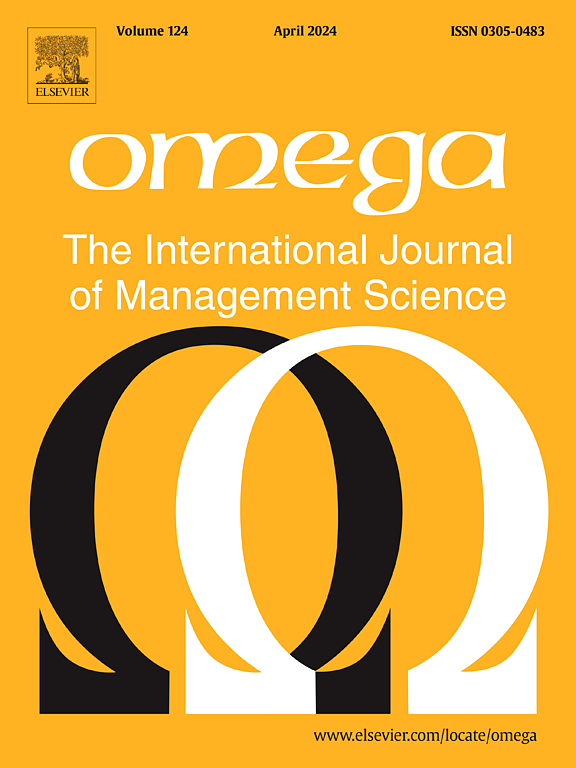Resilience Assessment of Supply Chain Networks Considering Continuously Varying Sates of Firms in Ripple Effect: A Comprehensive and Dynamic Operational-Structural Analysis
IF 7.2
2区 管理学
Q1 MANAGEMENT
Omega-international Journal of Management Science
Pub Date : 2025-03-13
DOI:10.1016/j.omega.2025.103322
引用次数: 0
Abstract
This study aims to develop a comprehensive assessment approach for supply chain network resilience from structural and operational perspectives in the presence of ripple effect, i.e., localized disruptions due to risk events can propagate rapidly within the network, leading to large-scale failure. The existing assessment works have two non-negligible problems. The first one is neglecting the continuous change of firms’ operation capacities and corresponding multiple states during disruption propagation. Another one is the lack of dynamic modeling of network-level operational resilience. These problems make previous studies fall short of the realistic scenario and cannot comprehensively assess the resilience of supply chain networks. This paper models the continuously changing operational capacities of firms and the corresponding multiple states transition relationship, which provides a more realistic and finer-grained portrayal of disruption propagation in supply chain networks, and serves as a foundation for accurately assessing performance changes of supply chain networks. This study also quantifies the dynamic changes in network-level operational performance based on viable supply chain theory by maximizing the total units delivered flow, enabling a more accurate and comprehensive assessment of operational resilience. Based on the results of large-scale simulation experiments and a real-world case study of Apple's supply chain network, we comprehensively analyzed how resilience factors including network type, network structure and firm risk capabilities influence different dimensions of supply chain network resilience. Based on our findings, we summarize several important managerial implications and provide suggestions for decision-making.
连锁效应下考虑连续变化企业状态的供应链网络弹性评估:一个全面动态的运营结构分析
本研究旨在从结构和运营的角度,开发一种在连锁反应存在下的供应链网络弹性的综合评估方法,即风险事件引起的局部中断可以在网络内迅速传播,导致大规模故障。现有的评估工作存在两个不容忽视的问题。一是忽略了中断传播过程中企业经营能力的持续变化和相应的多重状态。另一个问题是缺乏对网络级操作弹性的动态建模。这些问题使得以往的研究缺乏现实情景,无法全面评估供应链网络的弹性。本文建立了企业持续变化的经营能力模型和相应的多状态转换关系,为供应链网络中的中断传播提供了更真实、更精细的描述,为准确评估供应链网络的绩效变化奠定了基础。本研究还基于可行供应链理论,通过最大化总交付单元流量,量化了网络级运营绩效的动态变化,从而能够更准确、更全面地评估运营弹性。基于大规模模拟实验结果和苹果公司供应链网络的现实案例研究,综合分析了网络类型、网络结构和企业风险能力等弹性因素对供应链网络弹性不同维度的影响。基于我们的研究结果,我们总结了几个重要的管理启示,并提供了决策建议。
本文章由计算机程序翻译,如有差异,请以英文原文为准。
求助全文
约1分钟内获得全文
求助全文
来源期刊

Omega-international Journal of Management Science
管理科学-运筹学与管理科学
CiteScore
13.80
自引率
11.60%
发文量
130
审稿时长
56 days
期刊介绍:
Omega reports on developments in management, including the latest research results and applications. Original contributions and review articles describe the state of the art in specific fields or functions of management, while there are shorter critical assessments of particular management techniques. Other features of the journal are the "Memoranda" section for short communications and "Feedback", a correspondence column. Omega is both stimulating reading and an important source for practising managers, specialists in management services, operational research workers and management scientists, management consultants, academics, students and research personnel throughout the world. The material published is of high quality and relevance, written in a manner which makes it accessible to all of this wide-ranging readership. Preference will be given to papers with implications to the practice of management. Submissions of purely theoretical papers are discouraged. The review of material for publication in the journal reflects this aim.
 求助内容:
求助内容: 应助结果提醒方式:
应助结果提醒方式:


